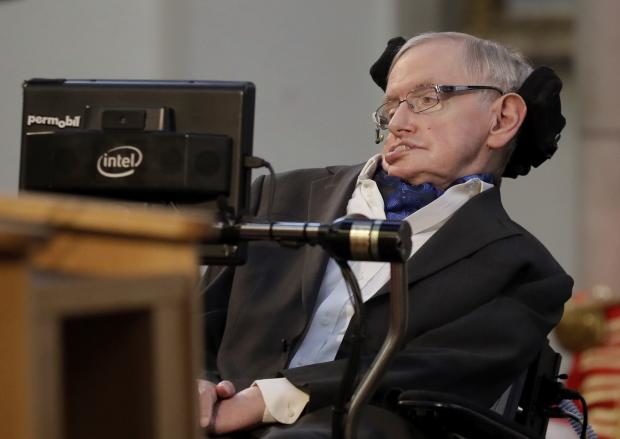
In this photo, taken March 6, 2017, Britain’s Professor Stephen Hawking delivers a keynote speech as he receives the Honorary Freedom of the City of London during a ceremony at the Guildhall in the City of London. Hawking, whose brilliant mind ranged across time and space though his body was paralyzed by disease, has died, a family spokesman said early Wednesday, March 14, 2018. (Photo by MATT DUNHAM / AP)
WASHINGTON — Everyone knew of Stephen Hawking’s cosmic brilliance, but few could comprehend it. Not even top-notch astronomers.
Hawking, who died at his home in Cambridge, England, on Wednesday at age 76, became the public face of science genius. He appeared on “Star Trek: The Next Generation” and “The Big Bang Theory,” voiced himself in “The Simpsons” cartoon series and wrote the best-seller “A Brief History of Time.”
He sold 9 million copies of that book, though many readers didn’t finish it. It’s been called “the least-read best-seller ever.” Hollywood celebrated his life in the 2014 Oscar-winning biopic “The Theory of Everything.”
In some ways, Hawking was the inheritor of Albert Einstein’s mantle of the genius-as-celebrity.
“His contribution is to engage the public in a way that maybe hasn’t happened since Einstein,” said prominent astronomer Wendy Freedman, former director of the Carnegie Observatories. “He’s become an icon for a mind that is beyond ordinary mortals. People don’t exactly understand what he’s saying, but they know he’s brilliant. There’s perhaps a human element of his struggle that makes people stop and pay attention.”
With Einstein, most people are familiar with e=mc2, but they don’t know what it means. With Hawking, his work was too complicated for most people, but they understood that what he was trying to figure out was basic, even primal.
“He was asking and trying to address the very biggest questions we were trying to ask: the birth of the universe, black holes, the direction of time,” said University of Chicago cosmologist Michael Turner. “I think that caught people’s attention.”
And he did so in an impish way, showing humanity despite being in a wheelchair with ALS, the degenerative nerve disorder known in the U.S. as Lou Gehrig’s disease. He flew in a zero-gravity plane. He made public bets with other scientists about the existence of black holes and radiation that emanates from them — losing both bets and buying a subscription to Penthouse for one scientist and a baseball encyclopedia for the other.
“The first thing that catches you is the debilitating disease and his wheelchair,” Turner said. But then his mind and the “joy that he took in science” dominated. And while the public may not have understood what he said, they got his quest for big ideas, Turner said.
Andy Fabian, an astronomer at Hawking’s University of Cambridge and president of the Royal Astronomical Society, said Hawking would start his layman’s lectures on black holes with the joke: “I assume you all have read ’A Brief History of Time’ and understood it.” It always got a big laugh.
“You’d find the average astronomer such as myself doesn’t even try to follow the more esoteric theories that (Hawking) pursued the last 20 years,” Fabian said. “I’ve been to talks Hawking has given and cannot follow them myself.”
Hawking, who was born 300 years to the day after Galileo died, was the Lucasian Professor of Mathematics at Cambridge University. It was the same post that Isaac Newton held. Both physicists and astrophysicists claimed him as their own. And much of Hawking’s work was in the field of cosmology, a deep-thinking branch of astronomy that tries to explain the totality of the universe.
Hawking’s title “is not relevant here; what matters is what his brain did,” said Neil deGrasse Tyson, director of New York’s Hayden Planetarium. “We claim him as an astrophysicist because his laboratory was the universe.”
And Hawking’s black hole work in the mid-1970s made a crucial connection in physics. Until Hawking discovered radiation coming from black holes — named “Hawking radiation” after him — the two giant theories in physics, Einstein’s general relativity and quantum mechanics, often conflicted. Hawking was the first to show they connected, which Turner and others described as breakthrough at the time.
The concept that stuff, radiation, comes out of black holes may have upset science fiction authors, but it inspired young scientists such as Tyson, who described it as “spooky profound.”
The idea behind this was also novel because it said “black holes aren’t forever,” Turner said.
Hawking also pioneered a “no hair” theory of black holes that they were simple, with just spin, mass and charge and nothing else.
Both of those concepts are cornerstones of current black hole theory.
Hawking’s other work went beyond black holes into the more cosmic, the origins of the universe. Initially he theorized about the “singularity” of the baby universe in thick but elegant mathematical equations comparing early time to wave functions. Later, his own work contradicted some of that and he was instrumental to theories about inflationary cosmology, where the universe’s beginning is more of a half ball. That theory got its kick-start at a conference Hawking hosted in 1982 with a dinner party and croquet match, Turner said.
The high-concept theory-making didn’t quite match the personality behind it. Colleagues often mention his off-the-wall humor, his big grin, his stubbornness.
And even the public picked up on his cheeky attitude instantly, Turner and Freedman said.
“He added a human face to science,” Turner said. “It goes well beyond the wheelchair.”
The bigger story was how the public became fascinated with this small man, stuck in a wheelchair with a worsening disease, and an intellect that few could fathom. They related to the man, Stephen Hawking, and his story, Freedman said.
The insight he gave on the mysteries of the cosmos was just a bonus.